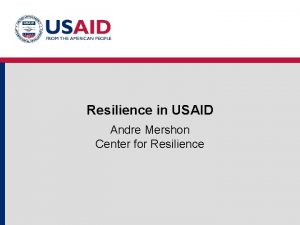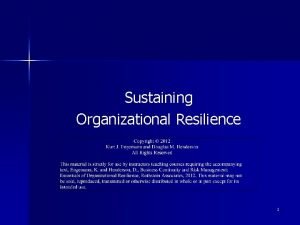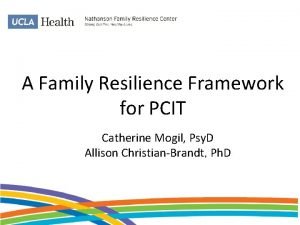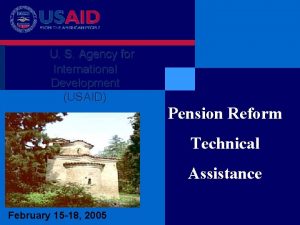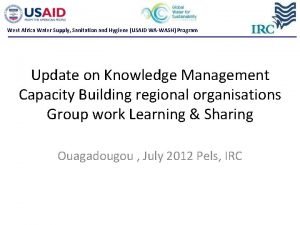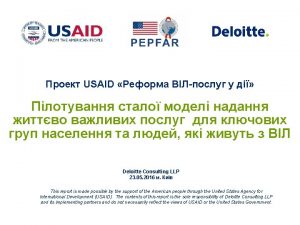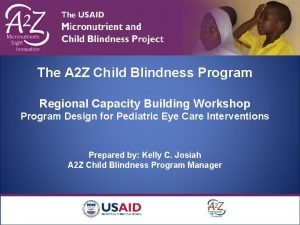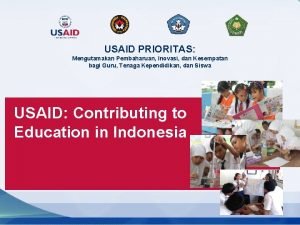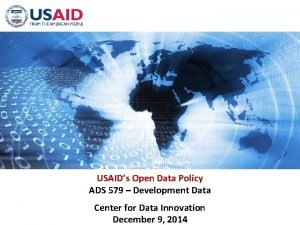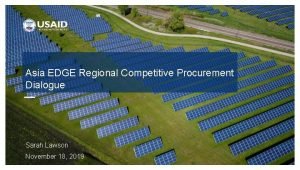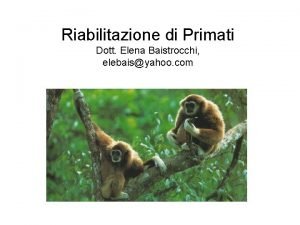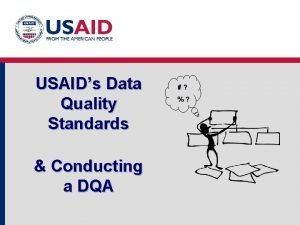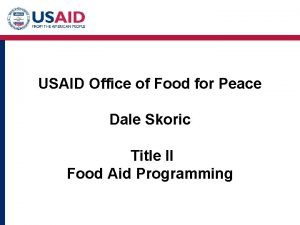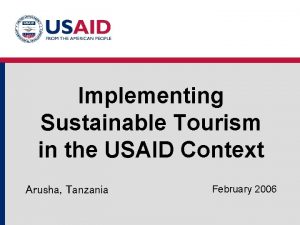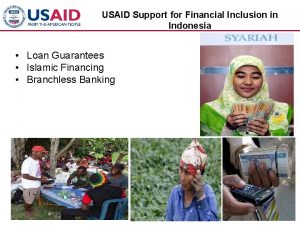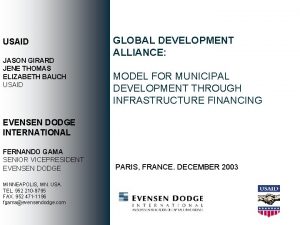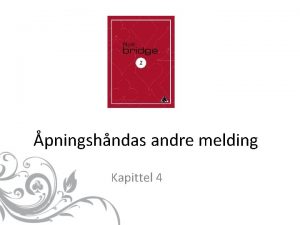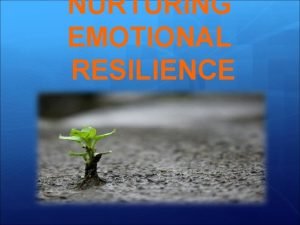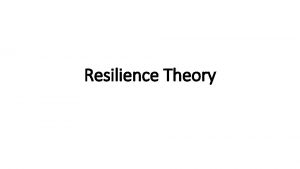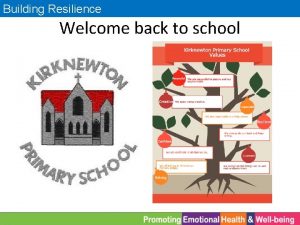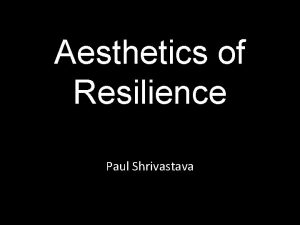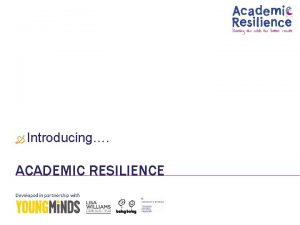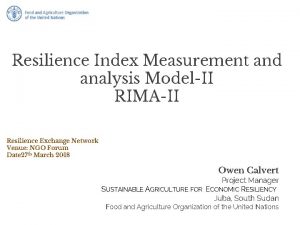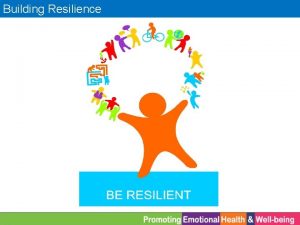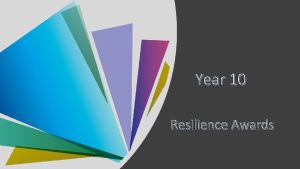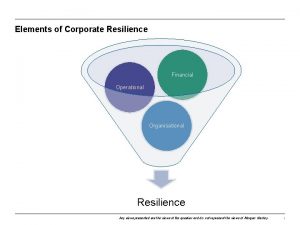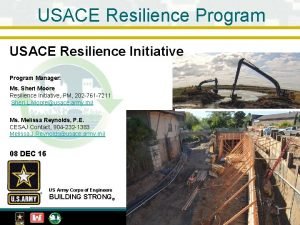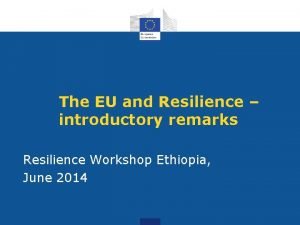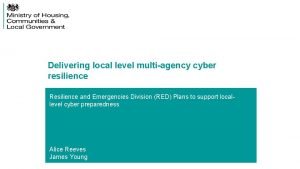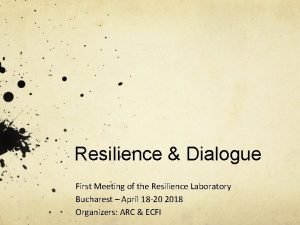Resilience in USAID Andre Mershon Center for Resilience


























- Slides: 26

Resilience in USAID Andre Mershon Center for Resilience

Key Toplines • The emergence of resilience as an agency priority in 2011 -12 has fundamentally changed where and how we work • Our efforts are part of broader, country-led efforts that are transforming the way we collectively manage and address recurrent crises and humanitarian risk. • These efforts are works in progress, but are already paying dividends – resilience and development gains – integrated response to emergent crises 2

Impetus & Rationale • Humanitarian Imperative: Lives, livelihoods, aspiration – 250, 000 excess deaths in Somalia in 2011 -12 (half children under 5) • Developmental Imperative: Economic losses as a result of drought in Kenya estimated at $12 b between 2008 -11 • Economic Imperative: USG spent in excess of $1. 5 b in responding to the drought crises in the Horn of Africa and Sahel in 2011 -12 alone – A 2013 study estimates that every $1 spent on resilience will result in $2. 9 dollars in economic benefit and reduced humanitarian spend 3

Defining Resilience USAID defines resilience as “the ability of people, households, Resilience is the ability to manage adversity and change communities, countries and systems to mitigate, adapt to and without compromising future well being recover from shocks and stresses in a manner that reduces chronic vulnerability and facilitates inclusive growth” - USAID’s Building Resilience to Recurrent Crisis (2012) 4

Key Features of USAID Resilience Efforts (What’s Different? ) 1. Developmental focus on people and places subject to recurrent crisis (previously a perpetual humanitarian risk) § § initially where recurrent crises = repeat, large-scale emergencies growing recognition of broader utility; EEP, FTF, El Nino… 2. Shocks and stresses more explicitly recognized as perennial features (not anomalies). Concurrent investment: § § to reduce/manage risk, build adaptive capacity, facilitate inclusive growth with flexibility to proactively respond (drought/shock cycle management) 3. Joint humanitarian and development analysis, planning and implementation (across sectors, systems thinking in an ear-marked world) § § resilience an analytic, programmatic and operational framework sequencing, layering and integration of HA/DA programs 5

Expansion of Focused Resilience Efforts to date Funding Sources: Funding Levels: DA, GH, FFP/title II, IDA, ESF + FY 2012: $288, 724, 172 FY 2013: $297, 513, 492 6 FY 2014: $328, 845, 707

Resilience Programmatic and Results Framework: Horn of Africa and Sahel Goal: Sustainable reductions in humanitarian assistance needs, prevalence/depth of poverty, household hunger, and acute/chronic malnutrition Purpose: Increased resilience of chronically vulnerable households and communities Objective 1: Expanded Economic Opportunities IR. 1: Diversified economic opportunities IR. 3: Increased access to financial services IR. 2: Objective 2: Strengthened Institutions and Governance Objective 3: Improved Health and Human Capital Intensified agricultural production & marketing IR. 1: Strengthened Natural Resource Management IR. 2: Strengthened Disaster Risk Management IR. 1. Increased use of health and nutrition services IR. 2. Improved health and nutrition practices IR. 4: Increased market infrastructure (physical) IR. 3: Strengthened conflict management IR 4: Strengthened institutional capacity and coordination IR. 3: Improved vocational skills (workforce) IR 4: Improved educational attainment Innovation and knowledge management / Gender / Private Sector Involvement / Functional Literacy 7

Kenya: $291 m 2012 -17 Partnership for Resilience and Economic Growth (PREG) USAID PREG programs reached 1. 5 m people in FY 13 and over 2 m in FY 14 (see annex for a list of programs implementing in resilience zone) 8

Kenya: USAID and Country -led Progress POSITIVE TRENDS (interim survey): decreasing depth of poverty and household hunger, increasing access to water and dietary diversity USAID Progress - Partnership for Resilience & Economic Growth • Expanding Economic Opportunities - Increased value of livestock sales from $23 m to $29 m, 350 k farmers/pastoralists applied new technologies, 10 k SMEs accessed loans • Strengthening Governance - 6 m hectares under improved NRM, 2. 6 m people covered by county contingency plans (NDMA), community planning enabled $12. 8 m in Go. K investment, insurance (IBLI/KLIP), 50, 000 in targeted hotspots engaged in peace-building • Improving Human Capital - 225 k with access to improved water sources, 881 k reached by nutrition programs, 420 health facilities strengthened Country-led Progress • Ending Drought Emergencies Strategy - $1. 6 b by Go. K matched by $1. 5 b donors – National Drought Management Authority for cross-ministerial coordination – ASAL donor working group for HA/DA donor/partner coordination in support of EDE • • Devolution of resources/authorities to counties - Disproportionately favoring ASALs Forward-leaning on Drought Cycle Management: ARC, KLIP, NDMA, CCPs 9

Ethiopia: $558 m 2012 -17 (Highlands: $328 m, Lowlands $230 m) USAID programs reached 2. 2 m people in FY 13 and over 2. 7 m in FY 14 (see annex for a list of programs implementing in resilience zone) 10

Ethiopia: USAID and Country-led Progress POSITIVE TRENDS: decreasing poverty and malnutrition (national), reduced food gap and distress sale of assets …. progress being tested/under threat (el Nino) USAID Progress in the Highlands and Lowlands • Expanding Economic Opportunities - Increased value of livestock sales from $6 m to $67 m, $15 m in private sector investment in livestock, 170 k farmers/pastoralists applied new technologies, 60 k in loans by SMSE, $330/year increase in income (GRAD), • Strengthening Governance - 542 k hectares under improved NRM, 1, 572 communities w/ functioning early warning/response systems, 1. 56 m benefiting from PSNP, insurance (IBLI) • Improving Human Capital - 213 k with access to improved water sources, 1. 3 m reached by nutrition programs, 29 k trained in health/nutrition Country-led Progress • PSNP IV – geographic and programmatic (nutrition/livelihoods) expansion, including to lowland areas, informed by USAID FTF/FFP program best practices, • Go. E and Donor Coordination – Pastoralism Technical Working Group, Rural Economic and Food Security Working Group + new national DRM structure • Agriculture Growth Program (AGP) – geographic and programmatic (nutrition/Climate Smart Agriculture) expansion 11

Niger and Burkina Faso: $304 m 2013 -18 Resilience in the Sahel Enhanced (RISE) USAID RISE programs reached 1. 3 m people in 2014 and 2. 56 m in 2015 (see annex for a list of programs that contribute to RISE) 13

Niger and Burkina Faso: USAID and Country-led Progress USAID Progress: Resilience in the Sahel Enhanced (RISE) • Expanding Economic Opportunities - 243 k farmers applied new technologies or management practices, 190 k farmers training (40% female), $6. 3 m in loans accessed by 1300 SMEs, 1, 300 savings groups have accumulated $772 k • Strengthening Governance - 23 k people have been trained in disaster preparedness, 592 communities with functioning disaster early warning and response systems, 243 k hectares under improved NRM, 106 communities engaged in conflict mitigation • Human Capital: Health and Nutrition – 137 kpeople trained in child health and nutrition, over 510 k children under 5 reached by nutrition programs, 76, 793 ‘couple years of protection’ achieved through USG FP programs. Country-led Progress • Niger - Support to ‘Nigeriens Nourish Nigeriens’ (3 N) as a cross-ministerial, country-led platform for food security and resilience (AGIR), Niger an early adopter of ARC insurance. 3 N supported through USAID learning platform to convene quarterly technical meetings • Burkina Faso – Validation of Country Resilience Priorities (PRPs) linked to AGIR through 4 regional workshops. USAID supporting Go. BF to develop cross-ministerial coordination mechanism (similar to NDMA in Kenya, 3 N in Niger). 14

Emergent Resilience Efforts in Horn, Sahel and Asia (baselines this year) Nepal – Joint analysis, planning and implementation by FTF, GH, GCC, DG, FPP, DRR in Far West and Center-East hills. • Expansion into earthquake impacted in Center-East hills Somalia – Joint mission, FFP, OFDA Resilience APS awarded to 3 NGOs in 2015 with activities that also support New Deal. Support to FAO/WFP/UNICEF flagship resilience program in Dolo region. Uganda – Joint analysis and planning across mission offices + expansion of FTF into Karamoja. Established ‘resilience secretariat’ to facilitate joint donor/Go. U analysis and planning. • Karamoja = 1 m people, 94% poverty, $210 in HA last 10 years Mali – Joint analysis, planning and implementation by FTF, GH, DG, GCC and Ed + new FFP development program. • targets northern Mopti; a site of recurrent crises (IPC) and a stability buffer between Timbuktu and Bamako 15

Future Directions and Broader Relevance • Ending Extreme Poverty Rate of ‘backsliding by Country (ODI) – Poverty dynamics: ‘backsliding’ and descents into poverty (ODI/IFPRI) • Support to Cambodia and Bangladesh • FTF ‘looking forward’ • Fragile Areas/States – Current portfolio targets fragile, conflictaffected areas and includes conflict mitigation and management activities • Somalia and Mali exemplify both opportunities and challenges • Providing a model: S. Sudan (APS) Fragility Risk: Ineffectiveness (CMM) • El Nino as an opportunity – Resilience a necessary condition for sustaining development gains in complex risk environments • Lessons from Ethiopia • Relevance to southern Africa and LAC 16

Structure to Drive and Institutionalize Resilience in USAID DCHA Assistant Administrator Tom Staal (co-chair) Resilience Leadership Council (BFS, DCHA, E 3, GH, PPL, Lab, AFR, Asia, ME) BFS Assistant Administrator Beth Dunford (co-chair) Mission Resilience Coordinators Mali Amadou Camara Niger Ahmadou Ndiade Sahel Scott Dobberstein (Susan Fine) Burkina Faso Siaka Millango RDMA Sheila Roquitte Center for Resilience Director/ Resilience Coordinator Greg Collins Senior Director of Partnerships Tom Beck Resilience Deputy Coordinator (TBD – FSO) M&E Specialist Tiffany Griffin KM&L Specialist Karine Garnier Country Support Andre Mershon Program Analyst Justin Prudhomme Regional Bureau Focal Points 0 Asia Nepal Laureen Reagan Asia: David Fox Kenya Jennifer Maurer ME: Charles Kiame AFR: Susan Thompson (SD) Chad Chapman (Horn) Stephanie Saenger (Sahel) Uganda Joe Hirsch Regional Programs Isaac Thendiu Horn Chip Bury (Karen Freeman) Somalia Anne Shaw Ethiopia John Edgar 18

Annexes 20

Conceptual Framework from Building Resilience to Recurrent Crises: Policy and Programming Guidance (2012) Exposure Sensitivity Chronic Recurrent Shocks, Poverty Crisis Stresses Access to Risk Assessment Tools Economic Opportunities Access to Education Livelihood Strategies Good Governance Women’s Empowerment Social Safety Nets And Financial Protection Adaptive Capacity Environment, Water, Sanitation & Management Nutrition and Health Services Resilient Response to Shocks, Stresses Sustainable Reduction in Vulnerability & Inclusive Growth Disaster Risk Reduction Early Warning Systems Risk Reduction Reduce Drivers of Conflict 21

Baselines and Targets for Topline Indicators in the Horn and Sahel ETHIOPIA Baseline Target KENYA Baseline 12 m Population in Zone Humanitarian Assistance 4, 500, 000 Needs (normalized by severity of drought) Target RISE (Niger/Burkina Faso) Baseline Target 4. 6 m 11 m 3, 875, 000 3, 750, 000 3, 375, 000 1, 875, 000 1, 500, 000 Depth of Poverty (mean gap in %) 26% 21% 25% 20% 22% 18% Moderate or severe hunger (prevalence) Global Acute Malnutrition (prevalence) 19% 15% 55% 44% 29% 23% 12% < 10% 13% < 10% 18% < 10% 22

Kenya – Partnership for Resilience and Economic Growth (PREG) partners Contributing Mechanisms in Resilience Focus Zone • Resilience and Economic Growth in the Arid Lands– Improving Resilience (REGAL-IR) • Resilience and Economic Growth in the Arid Lands– Accelerated Growth (REGAL-AG) • FFP Supported WFP Cash and Food for Assets Program (C/FFA) • APHIA-plus Integrated Marginal Arid Regions Innovative Socialized Health Approach • Kenya Arid Lands Disaster Risk Reduction – mission/OFDA WASH Program • Northern Rangelands Trust • Agile Harmonized Assistance for Devolved Institutions (AHADI) program • OFDA Resilience (Early Recovery + Transition + DRR) Evaluation timeline: 2013, 2015, 2017 23

Kenya Promising Trends: Intermediate and Topline Outcomes from Interim Survey Depth of Poverty 2013 Baseline to 2015 Interim Values 2013 baseline 2017 Targets unit change 2015 interim (pp , #, or $) % change unit change 2017 Endline (pp , #, or $) % change 30. 5% 26. 8% 3. 7% 12. 1% 24. 4% 6. 1% 20. 0% Poverty Prevalence 61. 9% 58. 5% 3. 4% 5. 5% 49. 5% 12. 4% 20. 0% Moderate or Severe Hunger (%) 60. 3% 54. 5% 5. 8% 9. 6% 48. 2% 12. 1% 20. 0% Wasting 12. 8% 18. 6% 5. 8% 45. 3% 10% 2. 8% 21. 9% Stunting 27. 6% 26. 3% 1. 3% 4. 7% 22. 1% 5. 5% 20. 0% $23 m $29 m $6 m 26. 1% $35 m $12 m 50. 0% 2. 3 2. 95 0. 65 28. 3% - - - 5. 0% 14. 3% 9. 3% 186. 0% - - - 19. 8% 31. 0% 11. 2% 56. 6% - - - 52. 9% 68. 6% 15. 7% 29. 7% - - (mean gap in % terms) Value of Livestock Sales (Marsabit/Isiolo only) Women's Diet Diversity* (avg # food groups) Children - Minimum Dietary Diversity (%) Children - Minimum Meal Frequency (%) Access to Improved Water Source * difference between baseline and interim is statistically significant at p<. 05 24

Ethiopia – Programs in Resilience Zones (highlands/lowlands) Contributing Mechanisms in Resilience Zone • The Pastoralists Areas Resiliency Improvement through Market Expansion (PRIME) Program • Water , Sanitation, and Hygiene Transformation for Enhanced Resilience Program (WATER ) • Productive Safety Net Program (PSNP) • Graduation with Resilience to Achieve Sustainable Development (GRAD) in highlands • Building Resilience in Gode Zone, Somalia Region • Work Force Development (WFD) • Agriculture Knowledge Program (AKLDP) • Land Administration to Nurture Development project (LAND) • Empowering New Generations to Improve Nutrition and Economic Opportunities (ENGINE) • Promoting opportunities through training, education, transition, investment and livelihoods for youth (POTENTIAL) • OFDA Resilience (Early Recovery + Transition + DRR) Evaluation timeline: 2013, 2015, 2017 25

Ethiopia (Recurrent Monitoring System): Food Security Index by Drought Severity Index • During a moderate drought (Jigjiga), households were able (on avg) to maintain and even improve food security status over 6 mo. • During a more severe drought (Borena), households were unable (on avg) to maintain food security status over 6 mo. • Resilience capacities help moderate the impact of drought on food security status, even when controlling for poverty/assets 26

Ethiopia: Activities that are Strengthening Resilience Capacities ABSORPTIVE CAPACITY • cash savings • informal safety nets • disposal of assets accumulated during nonshock years • disaster risk reduction strategies • hazard insurance • bonding social capital ADAPTIVE CAPACITY • better access to information • diversifying livelihoods risk profiles • bridging and linking social capital • accumulating assets • access to financial services • improved nutrition and health status • increased confidence to adapt TRANSFORMATIVE CAPACITY • • • improved governance access to formal safety nets access to markets access to basic services access to agricultural services Access to communal natural resources access to infrastructure bridging and linking social capital empowering women Improvements in social inclusion (those in bold had the strongest influence in terms of mediating declines in Food Security in RMS round 1) 27

Ethiopia: PSNP’s Impact on Food Security & Resilience • PSNP and related programs are responsible for a quarter of the total poverty reduction since 2005 (WB 2015) • Food gap reduced: Food gap reduced from 3. 09 months in 2006 to 1. 75 months in 2014 (PSNP 2015) • Household diets improved: Average consumption of 3. 3 food groups in 2006 to 4 food groups in 2014 • Household assets protected: In 2014, 25% of HHs reported making a distress sale of assets to meet their food needs, whereas 54% of HHs reported doing so in 2010. • Public Works contributed to environmental transformation at scale, reversing degradation and improving biodiversity, crop health and livestock productivity. 28

Niger and Burkina Faso – Resilience in the Sahel Enhanced (RISE) partners Contributing Mechanisms in Resilience Zone • Resilience and Economic Growth in the Sahel – Enhanced Resilience (ER) • Resilience and Economic Growth in the Sahel – Accelerated Growth (AG) • Sahel Regional Learning Program • USGS Papa (ecological systems analytics) • FFP Development Food Aid Programs: Mercy Corps, CRS, Save the Children and ACDI-VOCA • WFP-PRRO support (Niger) • DCA Eco-bank and Azuzu • GDA in design • Family Planning (AGIR) • Water and Sanitation (WAWASH) • Countering Violent Extremism (PDEV II) • OFDA Resilience (Early Recovery + Transition + DRR) • Regional Programs (indirect contribution) − Capacity Building ECOWAS, CILSS − Basic Education (NECS) − Family Planning (SIFPO) − Neglected Tropical Diseases (END) − WA Seed, Fertilizer and Trade Hubs Evaluation timeline: 2015, 2017, 2019 29
 Usaid resilience
Usaid resilience Mershon center events
Mershon center events Family resilience framework
Family resilience framework Usaid
Usaid Usaid
Usaid Deloitte usaid
Deloitte usaid Usaid child blindness program
Usaid child blindness program Egra reading assessment
Egra reading assessment Usaid ads 579
Usaid ads 579 Sarah lawson usaid
Sarah lawson usaid Usaid
Usaid Dqa standards
Dqa standards Usaid
Usaid Usaid sustainable tourism
Usaid sustainable tourism Brian dusza usaid
Brian dusza usaid Nyckelkompetenser för livslångt lärande
Nyckelkompetenser för livslångt lärande Offentlig förvaltning
Offentlig förvaltning Lyrik texte
Lyrik texte Personlig tidbok
Personlig tidbok Mantel för kvinnor i antikens rom
Mantel för kvinnor i antikens rom Iso 22301 utbildning
Iso 22301 utbildning Vilken grundregel finns det för tronföljden i sverige?
Vilken grundregel finns det för tronföljden i sverige? Verktyg för automatisering av utbetalningar
Verktyg för automatisering av utbetalningar Ministerstyre för och nackdelar
Ministerstyre för och nackdelar Jätte råtta
Jätte råtta Vem räknas som jude
Vem räknas som jude Expektans eller exspektans
Expektans eller exspektans
